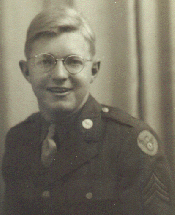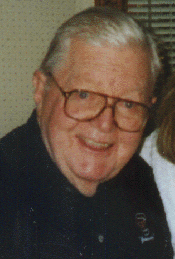A World War II Soldier’s Insight Into The ‘Mysterious Disappearance’ of Glenn Miller by Fred W. Atkinson, Jr.

This is Mr. Atkinson.
The picture was taken during WW II.

Mr. Atkinson at the time he wrote this article.
Today is April 10, 1999. I am seventy-five (75) years old. I was only twenty-one at the time of this event. Most of the men in our unit in 1944 would be 75 to 85, or older, at the time of this writing.
In the month of December 1944, I was a member of the 320th Air Transport Squadron based at Le Borge’ Airport at Paris, France. This squadron was a unit of Colonel Arnold’s Air Transport Wing. We were never connected physically to his Wing, except administratively, because we were an experimental air evacuation squadron designed to remove wounded soldiers from field hospitals and bring them back to Paris. There they were then sent to various other hospitals that were equipped to treat their specific types of wounds. The aircraft that we were using in this new operation were C-64’s, a single engine aircraft that was equipped with three stretchers and at times carried a flight nurse whenever one was available. These C-64’s were so small they could land on roadways, fields, or open spaces near the field hospitals and take off right away to return the wounded to Paris (rescue missions of this sort are conducted today through the use of helicopters). These aircraft had no navigation instruments, and they were grounded in bad weather conditions. This information is needed in order for one to understand what happened to our aircraft that carried Glenn Miller to his death. My job in our squadron was Personnel Records and Administrative Assistant to Major James R. Lyons, our Commanding Officer, and Lieutenant Charles S. Groseclose, our Adjutant.
On the day that Glenn Miller left London two of our aircraft were in London and were scheduled to return to Paris. A decision was made to cancel the flights due to the terrible weather conditions which existed between London and Paris. However, two of the pilots were ordered to fly Glenn Miller to Paris where he was to join his band (they had preceded him) to perform at the opening of SHAEF Headquarters at Versailles, which was being moved from London to Paris. This order was given by a Brigadier General we were informed (I do not recall the name). We were told this by the other flight crew that remained in London until the weather improved.
You will recall in the movie, “The Glenn Miller Story”, the letter that Glenn Miller wrote to his wife that day he expressed the feeling that he might not see them again. Given the weather conditions and the type of aircraft that was a realistic probability.
Several days after our plane left London, we were notified that an aircraft that might be ours had crashed on the coast of France and that the occupants were dead. We dispatched a plane to that location and the aircraft and the bodies of our pilots were identified. Our crew also said that the other body definitely was that of Glenn Miller. They said there were identification papers and dogtags that were on his body. Our second crew that was in London at the time verified they had witnessed Glenn Miller and our two pilots board the aircraft and depart.
I recall the papers being processed to salvage our aircraft and report the death of our pilots on the squadron morning report. This report was turned in on a daily basis and notes the changes in status of all personnel as they occur. We had not experienced any deaths in our squadron until this time and this was a “double whammy” to us because of the loss of our pilots and the loss to the U. S. Armed Forces of probably the greatest moral booster (along with Bob Hope) that we all loved.
It was rumored that the officers in our squadron had pledged to bring manslaughter charges against the General but they were advised that they could not do that until he was officially pronounced “dead”. It was also rumored that they intended to do this whenever the death announcement was ordered. I was always under the impression that no one could be listed “missing in action” forever and after a certain length of time they had to be pronounced killed in action or some other reasonable explanation. I have often wondered if any of our officers are still waiting for this action. I have watched over the years for an official announcement that Glenn Miller was killed in action and I have never seen one.
I have listed all of the names and facts that I can remember. I can clearly picture the faces of many of the members of our squadron, but I have difficulty remembering most of their names. I was assigned to our squadron about six months prior to the invasion of Normandy, so most of our unit was together for only about twelve or thirteen months before the war ended in Europe. I was discharged one year and sixteen days (New Year’s eve, 1945) after the fateful flight.
We could never understand why this was not brought to a conclusion. There were enough witnesses at the time to have confirmed these events. I don’t doubt Fred Shaw’s logbook (see AP article, Sat., April 9, THE STATE, “Book may explain Glenn Miller’s death”) and his seeing a small plane spiraling out of control. However, I do not see how this could have been the aircraft that crashed into the coast of France.
I have written my recollections in the hope that this information might help those who are still wondering what happened in the “mysterious disappearance of Glenn Miller” the creator of the ever popular Big Band Sound. Perhaps my observations will help to answer the questions of Glenn Miller’s many fans and “one of aviation’s most captivating puzzles”.
Fred W. Atkinson, Jr.
Chapin, South Carolina
Mr. Atkinson passed away at his home in Irmo, SC on May 4, 2008.
A shortened version of Mr. Atkinson’s article was published in ‘The State’ Newspaper on December 27, 1999 on page A6.
LIST OF PERSONNEL OF THE 320TH AIR TRANSPORT
SQUADRON THAT I AM ABLE TO RECALL
· First Sgt. Kitchens – from Louisiana
· S/Sgt. Hans Ruwalt, Headquarters clerk from Brooklyn, NY
· Lieutenant Rogge, Pilot
· Captain Sleigh, Pilot – An American citizen, initially RAF pilot until
U. S. entered the war, transferred to U. S. Air Corps
· Major J. R. Lyons, Commanding Officer
· Lieutenant Charles S. Groseclose, Adjutant
· M/Sgt. Smith, Chief Engineering Section
· Sgt. Miller, Supply Sgt.
· Cpl. “Moose” Hasselman – Played football for Columbia University and
returned after the war and played for several years. His name was in the
newspaper on several occasions about l946-47.